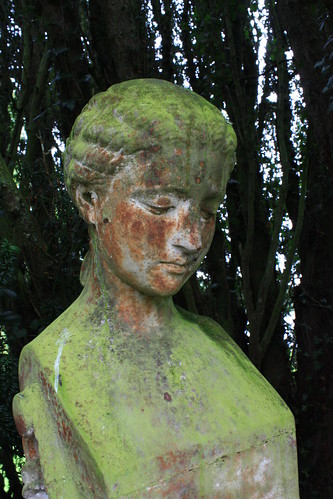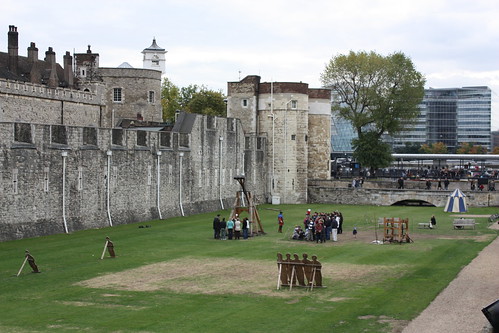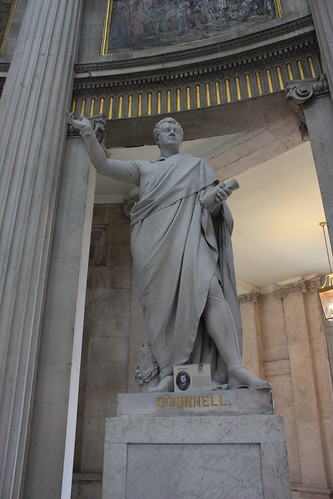A Not-So-Brief History of Ireland

Sculpture at Castle Leslie, near the border of Ireland and Northern Ireland.
–
If my recent posts have seemed more pithy than usual, it is because I am skirting around an issue that I’m not sure I have the blogging chops to tackle, and talking about banal things like cryptic showers and trendy restaurants is far easier.
Hell, writing about how I turned my bathroom into a vomitorium (in one easy step!) is easier than tackling this.
But I really can’t keep avoiding it, since I can’t fully tell you about our visit to Ireland without addressing its history.
That’s right: today’s post will be an incredibly long, dull, and somewhat inaccurate history lesson. I’ll be discussing the Republic of Ireland, Northern Ireland, and I might touch on the issue of The Troubles, if my brain isn’t too scrambled.
Let me say right now: I’m going to do a crap job of explaining it. I just am. There’s no way around this. I took a bunch of tours, I read a bunch of articles, and we even visited the Northern Irish Parliament. I spoke for long hours with individuals from both Northern Ireland and the Republic of Ireland. I got a rudimentary understanding of the island’s history, and how things are now, and I want to share it with you.
But it’s probably going to be woefully wrong. Feel free to call me out on anything I really muck up. And feel free to openly disagree with me. Ireland’s history is not an impartial one – even for an outsider, even for a self-proclaimed recovering Catholic who is happily married to a non-practicing Jewish man – it’s virtually impossible not to put your own spin on things.
And so, with all those caveats and disclaimers, here we go.
There are currently several places in Europe with “Ireland” in their name.
One is The Republic of Ireland. It is its own sovereign state, and part of the European Union. Citizens have passports that read “Republic of Ireland”. The country is part of the European Union, and the currency is the Euro. It consists of 26 counties, which make up the major part of the large island commonly referred to as Ireland.
The other is Northern Ireland. It makes up the northern portion of the island, and shares a border with the Republic of Ireland. The six counties of Northern Ireland are part of the United Kingdom. The residents there are British citizens (though that statement is up for debate amongst some who live there; more on that later). Though part of the U.K., Northern Ireland has its own local government and is largely autonomous. However, there are limits on what the Northern Irish Parliament can do – for example, they can’t declare war, or pass any laws with regards to foreign states (no signing of treaties or anything like that).

The Republic of Ireland is outlined in pink. Northern Ireland is at the top right. Notice there are parts of the Republic which actually extend further north than Northern Ireland. Contrary to popular belief, this was NOT done just to screw with cartographers.
–
How did this all come to pass? For that, we’ll have to go back in time a little.
Make that waaaay back in time. 1166, to be specific. This was the year of the Norman invasion, when England took over the island of Ireland (derived from the name given to the island by the Romans – Hiberne, meaning “land of endless winter”. According to one tour guide I had, that’s why the Romans never tried to conquer Ireland. It was waaay too cold for togas).
Prior to the Norman Invasion, Ireland was divided into regions led by local kings (or “petty kings” as they are often referred, but that term sounds judgmental to me). The local kings were all fighting for control of the entire island.
King Henry the II of England was worried that if all the fighting within Ireland ended and a single king emerged, he’d have a new, viable threat to contend with, so he headed out to gain control of the island.
This was how the entire island of Ireland (all 32 counties – encompassing present day Northern Ireland and the Republic of Ireland) came to fall under British rule. The Brits were fairly laissez-faire about Ireland until the reign of Henry the VIII.

Speaking of Henry, here’s something Medieval-type thingy going on at the Tower of London.
–
Henry’s wishes to have his first marriage (which produced a daughter, Mary, but no male heir) annulled led to his split with the Catholic Church, and brought about the Reformation. As a result, England became a largely Protestant nation.
The Reformation didn’t quite catch on over in Ireland; folks there were, and remained, Catholic. Henry was not down with that, and so he sent a large number of Protestant settlers over to Ireland. They displaced the Catholic landowners, and as numerous new regions were created, populated entirely by the Protestant settlers, they were able to overthrow the Catholic majority in the Irish Parliament, and eventually banned Catholics from Parliament altogether.
Meanwhile, back in England, Henry went through several more wives and went from being rather charismatic and handsome (if The Tudors is to be believed. Frankly, HBO has lied to me before. New York is nothing like Sex and the City made it out to be) to looking just a weensy bit like Jabba, minus the sex appeal. He died, and Mary, his estranged Catholic daughter from his first marriage, took the throne.
During her reign, she went about killing a lot of Protestants and earned herself the nickname “Bloody Mary”. (I realize that statement sounds like I’m judging her, and I’m not. I’m sure she had her reasons to go about murdering a bunch of people because their take on Christianity was slightly different than hers.)
Because getting really drunk is apparently a lot like being killed for your religious beliefs, the hungover can now enjoy a drink named a Bloody Mary. (Look, if you have a better explanation than that, I want to hear it.)
After Mary died, her Protestant half-sister, Elizabeth, took the throne, and went about undoing a lot of Mary’s work (though she was less into systematic murdering than Mary, so she mostly just reinstated a bunch of laws). She was on the throne for more than forty years, and while there is no cocktail named in her honor, she was able to tie the Protestant Church to England’s national identity.

Several centuries later, Judi Dench portrayed her opposite Colin Firth, and IT WAS AWESOME.
–
After a thousand words, let’s do a brief recap: we’ve got Ireland, populated largely by Catholics, but ruled over by a small group of Protestants (on behalf of the crown), and we’ve got England, largely populated and ruled by Protestants. And we’ve got a lot of bad blood on both sides.
So, the tension and animosity continued for quite a while. Like, a few hundred years. In Ireland, there were a bunch of laws on the books that limited the rights of Catholics. Many of these were not repealed until a lawyer named Daniel O’Connell founded the Catholic Association in the 1820s. By mobilizing a base, they were able to get the Catholic Relief Act of 1829 passed.

Statue of Daniel O’Connell in Dublin’s city hall.
–
So now Catholics could hold office in Ireland (but only wealthy Catholics could vote – a concession of the agreement). This was the start of the push for Home Rule in Ireland.
At this time, there were two distinct groups within Ireland, largely determined by religion. There were Unionists, who identified themselves as British, and wanted to continue being united with Britain (this group was predominately Protestant). And there were Nationalists, who wanted Ireland to be its own nation (and were predominately Catholic).
(Obviously, there are exceptions to this huge generalization I’ve made, and there were much smaller groups within these larger ones, but I’m not going to go into that right now for the sake of my own sanity and my limited understanding of the issue. Feel free to elaborate/correct my statements in the comments. But for the love of Pete, be merciful.)
Home Rule was what many Nationalists were seeking up until WWI (a few bills were drafted, but weren’t passed into law by the U.K. government). Home Rule means that while you are still part of a larger country (in this case, the United Kingdom), you are basically self-governed. The government of Scotland (while still technically part of the U.K.) falls under Home Rule. And many people consider the individual fifty states to be under home rule of the United States (though I would argue that’s a bit different).
Just when the plans for Home Rule seemed to be making some headway with the U.K., WWI broke out, and things were placed on the back burner. Britain was greatly preoccupied with the war effort, and during Easter of 1916, a few Nationalists in Ireland saw an opportunity.
The leaders of a handful of different Nationalist groups banded together and drafted a Proclamation (known as the Easter Proclamation) which declared Ireland’s independence from the U.K. It was read aloud on one of the main thoroughfares in Dublin. This marked the beginnings of the Easter Rising.
It didn’t quite go as planned. Although there was a lot of support for the idea of being separate from the U.K. among Nationalist groups in Ireland, there wasn’t one unifying group to bind them all together. And many folks were still pursuing Home Rule, which had almost been attained. More than 200,000 Irishmen were also fighting in WWI as part of the U.K. Things were not calm at home to begin with, and now a small group had declared independence, but it wasn’t a widespread, coordinated effort.
For a lot of folks, it meant that they simply woke up, saw a great deal of fighting and bloodshed in the streets, and were suitably horrified. They weren’t about to take up arms and fight, because it wasn’t even clear what the hell was going on.
After a few weeks, the uprising came to an end. Hundreds of people had died, and there were many civilian casualties, as the fighting had happened on city streets. Dozens were imprisoned (including a man by the name of Eamon de Valera, who went on to be one of the most important political figures in Ireland. More on him later). The leaders of the uprising who had signed the document were tried and sentenced to death.
Initially, the uprising had little support in either Ireland or England (those pushing for Home Rule felt that the uprising had damaged all the headway they had made). But the treatment of the prisoners was so terrible, and the execution of the Easter Rising leaders so brutal (one man, James Connolly, was so ill from his wounds, that he was unable to stand in front of the firing squad. So they brought him a chair, but he was too ill even to sit. So they tied him to a chair and then shot him. Another leader of the uprising was allowed to marry his fiance the day prior to his execution. His bride, Grace Gifford, went from being a wife to a widow in the span of 24 hours), that by the time the rest of the prisoners were released, the Irish public opinion had turned in their favor.

The spot where James Connolly was executed.
–
Okay – we’ve nearly hit 2,000 words. Are you still with me? After initially castigating them, The Irish public has now sided with the individuals who took part in the Easter Rising. Ireland was still a part of the U.K. There were Unionists in the north, who wished to remain part of the U.K., and there were Nationalists pretty much everywhere else, who did not.
This led to much more cohesiveness among Nationalist groups in Ireland. Several groups came together under the title of Sinn Féin – a political party which had already existed prior to the Easter Rising, but hadn’t been nearly as strong or large as it now was. The party was able to take control of Irish Parliament, winning 73 of Ireland’s 105 seats in the 1918 election (Sinn Féin continued to be a minority in Ulster, to the north, where seats were still controlled by Unionists.) Rather than meet in Westminster, representatives (known as MPs) set up their own Parliament in Ireland and met there. This new Parliament was known as the First Dáil.
The Ulster Unionists did not join them.
Now the Irish Nationalists had a cohesive party and significant control of Irish Parliament. They were able to better pursue the goal of Ireland as a sovereign nation. In 1919, Sinn Féin once again repeated the Declaration of Independence originally made during the Easter Rising, and noted that it considered Ireland to be at war with England. The Irish Republican Army emerged during this time, as a means of taking a militant stand against what they considered to be British occupation.
Thus began the Irish War of Independence, which ended in a truce two years later. Per the terms of the Treaty, the six predominantly Protestant Unionist counties to the north voted on whether they wanted to be part of the new Irish Republic. They stuck with the U.K.
In December, 1921, The treaty was signed by several of the members of the Irish Parliament – most notably, a gentleman by the name of Michael Collins – who were supposedly representing the interests of all Irish Nationalists.
The 26 southern counties of Ireland were now a free state.
There was a problem, though. Not all the Nationalists – indeed, not all the members of the First Dáil – agreed with the treaty. They wanted a unified Ireland – one that included the six counties to the north. Eamon de Valera, one of the men imprisoned during the Easter Rising, was anti-Treaty, and he had many supporters. They felt that signatories of the Treaty had forced them into an agreement that they didn’t support. (Though Michael Collins would argue that Eamon de Valera had sent him to sign the treaty, knowing that Collins would face the backlash for it).
The growing anger between those who were Anti-Treaty (Eamon de Valera and the Irish Republican Army) and those who were Pro-Treaty (Michael Collins and others), led to the Irish Civil War.
The Civil War went on for a year – ending in May, 1923 – and arguably killed more people than the Anglo-Irish War (Michael Collins was among the casualties).
The war between the Nationalist factions in Ireland left deep wounds that lasted for generations. The only thing it seemed to accomplish was that it gave Northern Ireland time to consolidate itself – the six counties that were still part of the U.K. wanted nothing to do with the new republic.
By the 1950s, things had more or less calmed down in the Republic of Ireland. Eamon de Valera was now a key political figure, serving several terms as President.
But in Northern Ireland, the Troubles were just beginning. Literally.
Aaaand … you know what? I’m exhausted. If you are somehow still reading this, I suspect you’re probably knackered, too. The Troubles were a significant part of Northern Irish history in the 1900s, and pertain directly to many of the places we visited in Belfast. They deserve their own blog post. So I’ll tackle that issue later in the week.
In the meantime, I hope this post, despite what I’m sure were some glaring omissions and errors, gave a smidgen of insight into what happened in Ireland over the last century or so. It would be near impossible to discuss anything we saw without first laying out this groundwork.









Leave a Comment